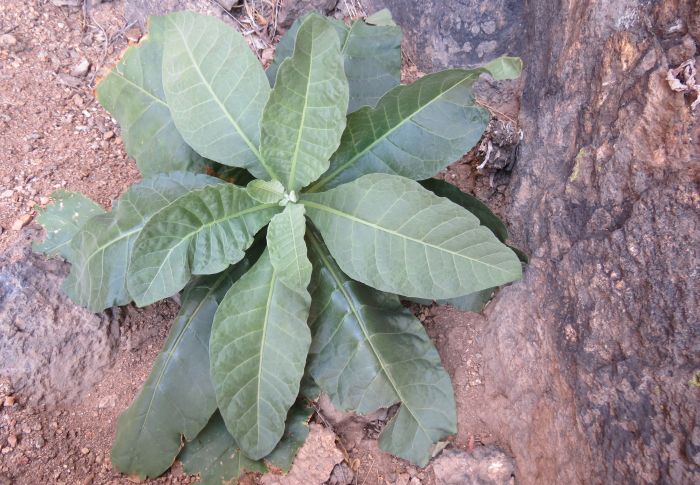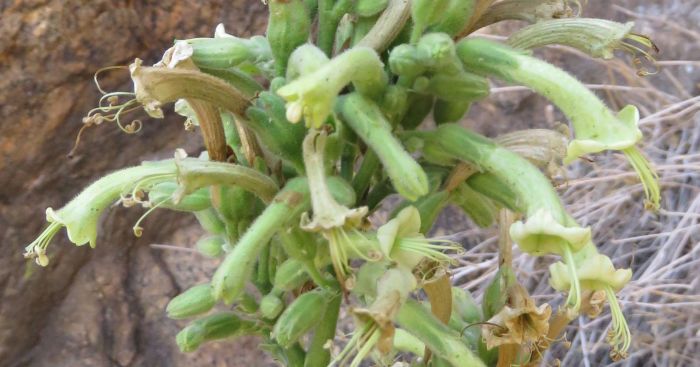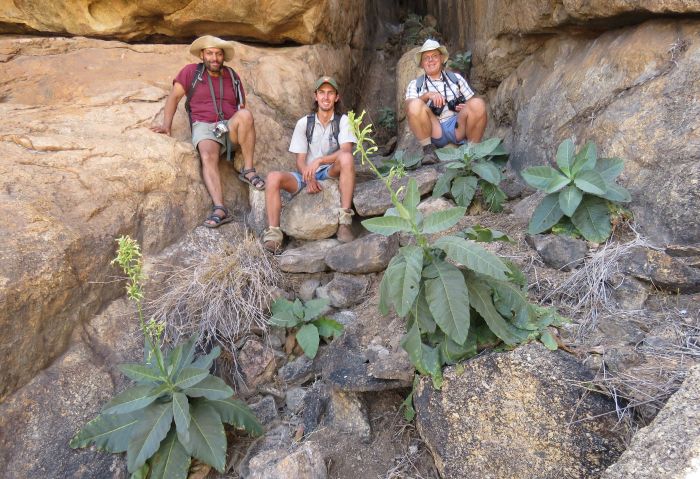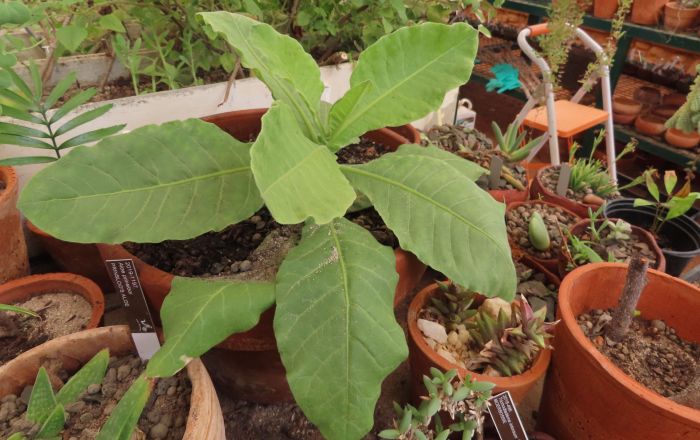Nicotiana africana
Nicotiana africana Merxm.
Family: Solanaceae
Common names: African tobacco (Eng.); Afrika tabak, Afrika-twak (Afr.)
Introduction
The African tobacco (Nicotiana africana) is a branched shrub, bearing yellowish green, curved, tubular flowers in summer, only known from a few mountain tops in northern Namibia where it grows in the shade of granite boulders and deep fissures, on drainage lines; it is the only tobacco indigenous to Africa. Easily grown from seed, best for dry, desert gardens grown in a shady position.

Fig. 1. African Tobacco, Nicotiana africana, in flower in its native habitat on the upper south slope, below a sheer cliff, in the western Sptiskoppe, Nambia.
Description
Description
Branched, woody shrubs up to 2.5 m tall; stems up to 20 mm wide. Initially softly herbaceous, with large leaves more than 400 mm long clustered in a basal rosette and as the plant matures and the stems lengthen, the leaves becoming smaller. Younger branches covered in glandular hairs. Leaves alternating, ascending spreading, the basal leaves ovate-lanceolate to elliptic, up to 400 mm long and about 200 mm broad, becoming smaller upwards; the leaf base wedge-shaped and the tip acute to rounded; the margin entire, but wavy; the veins pinnate (12–14), lighter green. The petiole is short, winged and with a basal ear-like protrusion (auriculate).

Fig. 2. A young plant of Nicotiana africana in habitat on a cliff ledge on the Spitskoppe; notice the leaves in a central rosette.
Inflorescence in conspicuous clusters at the branch ends, up to 450 mm long, bearing up to 10 flowers. Flowers ascending, on short stalks 7–15 mm long and 4 mm in diameter, tubular, distinctly curved, 30–40 mm long, ending in 5 spreading recurved lobes, yellowish green and densely covered with glandular hairs,. The calyx tubular 10–15 mm long. The stamens 9–16 mm long. The style more or less the same length as the stamens. Capsule broadly egg-shaped (ovate) ending in 4 valves. The seeds small, cone- to pyramid-shaped, 0.7–0.9 mm long, dark brown. Flowering time is in summer and autumn.

Fig. 3. A close-up of Nicotiana africana flowers (Spitskoppe, Namibia).
Conservation Status
Status
Nicotiana africana, although rare and localized from a few sites, is difficult to reach, some growing on inaccessible ledges, and thus, very well protected by its habitat.

Fig. 4. The rugged terrain of the Sptiskoppe, habitat of Nicotiana africana.
Distribution and habitat
Distribution description
Nicotiana africana is only known, at present, from the Spitskoppe, the adjacent Erongo and Brandberg Mountains in northcentral Namibia in the Namib Desert. Plants are only known to grow in sheltered positions among granite boulders and deep crevices and on drainage lines on upper slopes, where the plant benefits from rain showers. At the Brandberg, it was recorded at an altitude of 2 300 m (Giess 1982). On the western Spitskoppe the author and his team recorded N. africana plants on the upper south slopes, but always growing sheltered among boulders, some locations on cliffs and difficult to reach. The plant grows in a gravelly granite soil. The vegetation is sparse open desert and associated plants in the habitat include: Aeollanthus haumannii, Crassula tabularis, Euphorbia monteiroi subsp. brandbergensis (Brandberg bottlebrush ), Ficus ilicina (laurel fig) and Tetradenia riparia (iboza).
The habitat is shady, with gravelly, well-drained soil. Rainfall is mainly in summer in the form of thunder showers, 200–300 mm per annum. The average maximum temperature is about 28–30ºC and the average minimum about 12–18ºC. The climate is mild, but can become very hot in the summer. Winters are mild and frost is absent.

Fig. 5. Nicotiana africana plants on the Spitskoppe, Namibia growing on an upper shady south-facing cliff; notice the deep crevice and with rain water channeled to the plants below, the large size of the leaves and yellowish green flowers. (left, Werner Voigt, Curator of Kirstenbosch National Botanical Garden, centre, Cornell Beukes and right, Wessel Swanepoel).
Derivation of name and historical aspects
History
Nicotiana africana was named by the German Professor of botany Hermann Merxmuller (1920–1988) from Munchen, in the Mitteilungen der Botanischen Staatssammlung Munchen Band 12, pp. 91–104, in 1975. It was first collected by E.R. Scherz, who discovered plants at the Cymot Caves on the Farm Onguati of the Erongo Mountains, in northern Namibia. Plants were then sent to Professor Merxmuller in 1965 and at first they thought it to be an escaped Nicotiana cultivar. However, when more specimens turned up from other sites (Spitskoppe and Brandberg), its distinctness became apparent, the first and only record so far of wild tobacco in Africa, thus aptly named Nicotiana africana. Prior to this discovery, wild tobacco plants were only known from the Americas and Australia. What makes it even more significant, is that it belongs in section Suaveolentes (Subgenus Petunioides), a group of Nicotiana species with primitive characteristics known from Australia and the Pacific Ocean. It represents a surviving relict of a past wider distribution, and managed to hang on, in sheltered mountain tops among boulders, in northcentral Namibia. The only other tobacco species in southern Africa are the commercial, widely grown Nicotiana tabacum, the naturalised jantwak (N. glaucum) common in the western parts of southern Africa, as well as the ornamental N. longiflora. The author whilst exploring the Bayenes Mountains in Namibia near the border with Angola, came across Nicotiana tabacum growing on a south-facing rocky ledge at Omavanda Mountain, in June 2002, and probably an escapee or planted by the resident local Himba people. When he revisited the site with colleagues in November 2019, they encountered the same population.

Fig. 6. Tobacco, Nicotiana tabacum, plants found naturalized at a cave along a ledge at Omavanda, Bayenes Mountains, probably introduced the local resident Himba people.
The history of N. africana is also recorded by Willi Giess in 1982, as well as an account by Paul Herman in the Flowering Plants of Africa series in 1990, with a beautiful illustration by Gillian Condy.
The African tobacco belongs to the Solanaceae, a large cosmopolitan family with about 100 genera and about 2 600 species. The genus Nicotiana consists of about 80 species mostly from the Americas and the tobacco plant (N. tabacum) from the Americas, probably the best known, highly addictive nicotine substance (Christenhusz 2017).
The author visited the Spitskoppe in 2019 with his colleagues, Wessel Swanepoel, Werner Voigt and Cornell Beukes, especially to visit this interesting African tobacco and indeed found plants after a steep ascent on the upper south slopes of the eastern Spitskoppe of northerncentral Namibia. We were also fortunate to see its sunbird pollinator visiting the flowers.
Ecology
Ecology
Nicotiana africana has relatively large leaves and it is remarkable that a plant of its nature, with such large leaves, can survive in the Namib Desert. However, if one examines the specialist habitat, which is deep, sheltered, shady boulder crevices and drainage lines where moisture collects after rain showers, without it, this plant would have never been able to efficiently grow. The tubular curved flowers are visited by local sunbirds which are the main pollinators. After pollination the capsules ripen and seed is locally dispersed by wind and water. The cone-shaped seed gets jammed in a crevice or gravel, and then germinates with sufficient moisture after sufficient rain.

Fig. 7. Nicotiana africana in flower in its native habitat on the upper south slope, below a sheer cliff, in the western Sptiskoppe, Nambia.
Uses
Use
It is not known whether this particular species is used medicinally.

Fig. 8. Nicotiana africana grown from seed in the collection on Babylonstoren Farm, Simondium, Western Cape.
Growing Nicotiana africana
Grow
Nicotiana africana is a decorative shrub, best suited for dry Namib gardens and grown in a sheltered position, such as a shady part of the garden or in a container on a shady stoep (Van Jaarsveld 2010). Plants grow relatively fast. Outside of its habitat it is best grown in a greenhouse. The soil should be well-drained, sandy and plants fed with an organic fertilizer or compost.
Plants can be propagated from seed sown in spring or summer. Plant in a sandy soil, cover the seed with a thin layer of gravel or sand and place in a warm, shady position. Germination is usually within 3 weeks. Young plants grow rapidly and first develop a basal rosette. Seedlings can be potted up as soon as they are large enough to handle.
References
- Christenhusz, M.J.M., Fay, M.F. & Chase, M.W. 2017. Plants of the World, an illustrated Encyclopedia of vascular plants. Kew Publishing, Royal Botanic Gardens, Kew.
- Giess, W. 1982. Zur Verbreitung des Tabaks in Sudwestafrika Nicotiana africana Merxm. Dinteria 16: 11–20.
- Herman, P.P.J. & Gillian Condy.1990. Nicotiana africana. Flowering plants of Africa. Plate 2020.
- Merxmuller, H. & Butler, K.P. 1975. Nicotiana in der Afrikanischen Namib-ein pflanzengeographisches und phylogenetisches Ratsel. Mitteilungen der Botanischen Staatssammlung Munchen 12:91–104.
- Van Jaarsveld, E.J. 2010. Waterwise gardening in South Africa and Namibia. Struik, Cape Town.
Credits
Ernst van Jaarsveld
Kirstenbosch National Botanical Garden (Retired 2015)
Babylonstoren Farm
Extraordinary senior lecturer and researcher,
Department of Biodiversity and Conservation, University of the Western Cape
June 2020
Plant Attributes:
Plant Type: Shrub
SA Distribution:
Soil type: Sandy, Loam
Flowering season: Early Summer, Late Summer
PH: Acid
Flower colour: Yellow
Aspect: Shade, Morning Sun (Semi Shade), Afternoon Sun (Semi Shade)
Gardening skill: Average
Special Features:
Horticultural zones








Rate this article
Article well written and informative
Rate this plant
Is this an interesting plant?
Login to add your Comment
Back to topNot registered yet? Click here to register.